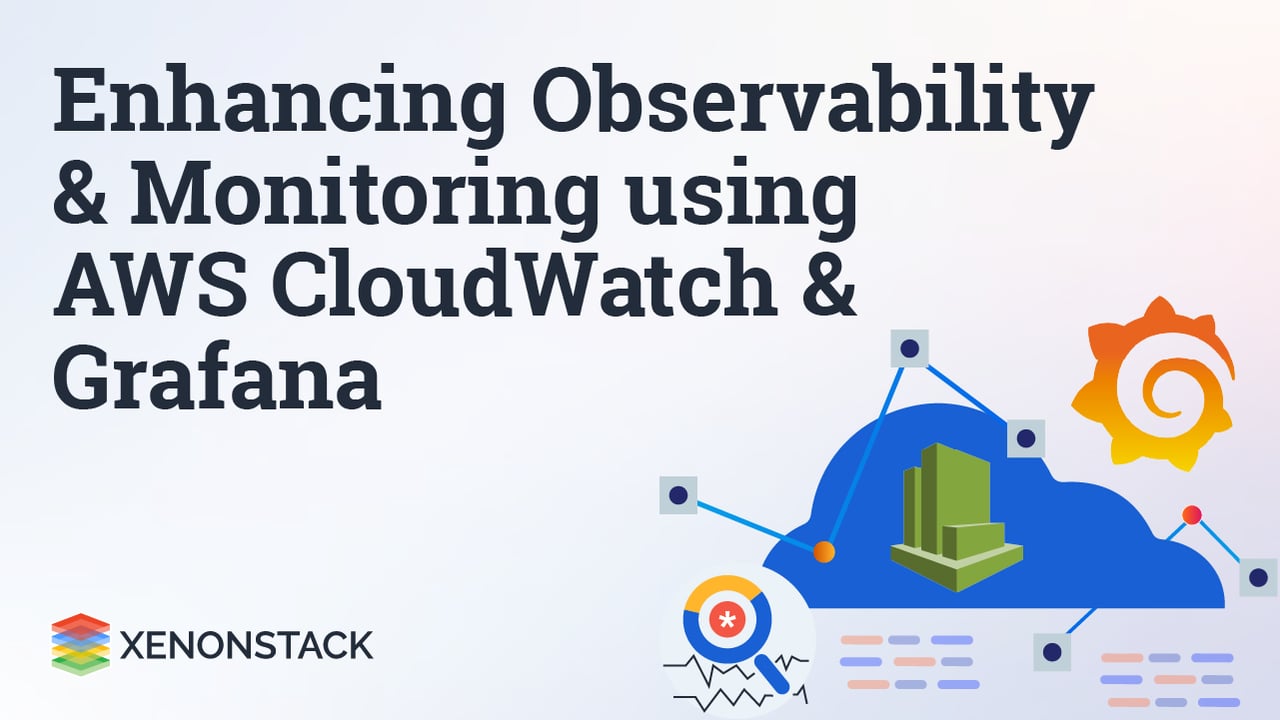
Introduction to CloudWatch
In today's rapidly evolving technology landscape, monitoring and observability are essential for managing complex applications and infrastructure. Amazon Web Services (AWS) offers Amazon CloudWatch as a native monitoring service to help organizations gain insights into their AWS resources and applications. While CloudWatch provides valuable metrics and dashboards, it may only partially satisfy all users' advanced monitoring and visualization needs.
The core problem is that CloudWatch has limitations in terms of customization, data retention, and advanced analytics capabilities. Organizations often require the ability to collect custom metrics, perform in-depth analysis, create highly customized dashboards, and set up sophisticated alerting mechanisms. Organizations can leverage Amazon Managed Service for Prometheus (AMP) and Amazon Managed Grafana to address these challenges and take their monitoring capabilities to the next level. This comprehensive solution enhances the capabilities of CloudWatch and empowers organizations to gain deeper insights into their AWS workloads.
Building the Solution
To address the limitations of Amazon CloudWatch and enhance monitoring and observability on AWS, organizations can adopt the following solution: -
Solution Components
-
Amazon Managed Service for Prometheus (AMP): AMP is a fully managed service that streamlines the deployment and operation of Prometheus, an open-source monitoring and alerting toolkit. With AMP, organizations can efficiently collect custom metrics and store them in a scalable and highly available manner.
- Amazon Managed Grafana: Amazon Managed Grafana is a fully managed service for the Grafana open-source dashboard and visualization platform. It enables users to create, customize, and share interactive dashboards to visualize and analyze their data effectively.
-
Amazon CloudWatch: While AMP and Grafana provide advanced monitoring capabilities, Amazon CloudWatch remains a fundamental service for collecting, aggregating, and storing logs and metrics from AWS resources. CloudWatch acts as a bridge between the AWS ecosystem and the custom metrics collected by AMP.

What are the Prerequisites for Implementing the Solution?
Before implementing this solution, organizations should consider the following prerequisites
- AWS Account: An AWS account is required with appropriate permissions to create and manage AWS services.
- Familiarity with Key Concepts: Users should be familiar with Amazon CloudWatch, Prometheus, and Grafana concepts to implement and configure the solution effectively.
- Existing AWS Workloads: Organizations should have existing applications or infrastructure deployed on AWS that require advanced monitoring and observability.
Overview of the Architecture Workflow:
The architecture workflow for leveraging Amazon CloudWatch metrics with Amazon Managed Service for Prometheus and Amazon Managed Grafana involves a series of interconnected steps:
Step 1: Set Up Amazon Managed Service for Prometheus (AMP)
-
Create an AMP Workspace: Utilize the AWS Management Console, AWS CLI, or AWS CloudFormation to create an AMP workspace.
-
Configure Data Sources: Integrate AMP with your existing Prometheus deployments or instrument your applications to send custom metrics to AMP.
-
Query and Analyze Data: Use the PromQL query language to explore and analyze the collected metrics within AMP, gaining deeper insights into application and infrastructure performance.
Step 2: Set Up Amazon Managed Grafana
-
Create an Amazon Managed Grafana Workspace: Establish a Managed Grafana workspace using the AWS Management Console or AWS CLI.
-
Configure Data Sources: Integrate Managed Grafana with your AMP workspace and other data sources like Amazon CloudWatch.
-
Create Dashboards and Panels: Design customized dashboards using Grafana's intuitive UI, adding panels to visualize your metrics meaningfully and visually appealingly.
Step 3: Integrate Amazon CloudWatch
-
Collect Metrics: Continue to use Amazon CloudWatch to collect metrics and logs from AWS resources such as EC2 instances, Lambda functions, and RDS databases.
-
Export Data to AMP and Grafana: Leverage CloudWatch metric filters and subscriptions to export selected CloudWatch metrics to AMP and Grafana, centralizing monitoring data.
Step 4: Create Advanced Dashboards and Alerts
-
Design Dashboards: Utilize the power of Grafana to create rich, interactive dashboards that consolidate data from AMP, CloudWatch, and other sources, providing a comprehensive view of the entire environment.
-
Set Up Alerts: Configure alerting rules within Grafana to trigger notifications based on predefined thresholds or anomaly detection, enabling proactive issue resolution.
Step 5: Monitor, Analyze, and Troubleshoot
-
Continuous Monitoring: Keep a vigilant eye on your dashboards and metrics to gain real-time insights into the performance and health of your applications and infrastructure.
-
Analyze and Troubleshoot: Use the combined data from AMP, CloudWatch, and Grafana to identify and resolve issues quickly, minimizing downtime and improving reliability.
Step 6: Scale and Optimize
-
Scaling: As your applications and infrastructure evolve, scale your monitoring stack to handle increased data volume and complexity, ensuring your monitoring solution grows with your needs.
-
Optimization: Optimize your dashboards and alerts to reflect changing business requirements and application demands, enhancing efficiency and cost-effectiveness.
AWS provides several tools and services that help automate our application and streamline our deployment and infrastructure. Understand more about Click to explore about, AWS Services For Blue-Green Deployments
Leading Use Cases
The solution of leveraging Amazon CloudWatch metrics with Amazon Managed Service for Prometheus and Amazon Managed Grafana provides a versatile set of use cases spanning various industries and AWS environments
Application Performance Monitoring (APM) -
- Microservices Performance: Monitor the response times, error rates, and latency of microservices and applications to ensure optimal user experiences.
- Serverless Function Monitoring: Visualize the performance of serverless functions, such as AWS Lambda, with custom dashboards to identify performance bottlenecks and optimize resource allocation.
Infrastructure Monitoring
- Resource Utilization: Track the utilization and health of AWS resources like EC2 instances, RDS databases, and Elastic Load Balancers to ensure efficient resource allocation.
- Capacity Planning: Set up alerts for resource scaling and capacity planning based on CloudWatch metrics, ensuring that resources are dynamically adjusted to meet demand.
Custom Metric Collection
- Custom Application Metrics: Collect and visualize custom application metrics that are not available out-of-the-box in CloudWatch, enabling deep insights into application behaviour.
- Prometheus-Formatted Metrics: Use AMP to scrape Prometheus-formatted metrics from applications and services, ensuring compatibility with existing Prometheus setups.
Log and Metric Correlation
- Holistic Troubleshooting: Correlate log data from CloudWatch Logs with metric data from AMP and CloudWatch, creating dashboards that provide a comprehensive view for effective troubleshooting.
- Root Cause Analysis: Analyse log events and metrics concurrently to pinpoint the root causes of issues, reducing mean time to resolution (MTTR).
Anomaly Detection and Auto-Scaling
- Anomaly Detection: Implement anomaly detection in Grafana to trigger auto-scaling actions based on unusual patterns or resource bottlenecks, ensuring optimal resource allocation and cost efficiency.
Cost Optimization
- Resource Rightsizing: Use comprehensive monitoring to identify underutilized resources and make informed decisions to right-size or terminate them, optimizing operational costs.
Compliance and Auditing
- Compliance Reporting: Meet compliance requirements by capturing and retaining historical metric data generating audit reports and visualizations for regulatory purposes.
- Data Retention Policies: Implement data retention policies and archival strategies to ensure compliance with data retention regulations.
Multi-Cloud Monitoring
- Multi-Cloud Environment: Extend this solution to monitor resources across multiple cloud providers, centralizing monitoring efforts and ensuring consistent observability across diverse environments.
Customer-Facing Dashboards
- Transparency and Collaboration: Share customized Grafana dashboards with customers and stakeholders to provide transparency into application performance and reliability, fostering collaboration and trust.
Customer Value Addition
Integrating Amazon CloudWatch metrics with Amazon Managed Service for Prometheus (AMP) and Amazon Managed Grafana (AMG) brings significant customer value across various cloud monitoring and observability aspects.
- Unified Monitoring: This integration allows customers to combine CloudWatch metrics, Prometheus metrics, and logs into a single, cohesive platform. It simplifies the monitoring landscape by eliminating the need for multiple tools providing a unified view of system and application performance.
- Enhanced Data Collection: Customers can extend their data collection capabilities with AMP by ingesting Prometheus-compatible metrics. This means a broader range of AWS resources and application metrics can be collected and analyzed. This richer data set enables more profound insights into the health and behavior of workloads.
- Scalable and Managed Solution: AWS manages the underlying infrastructure for AMP and AMG, ensuring scalability, high availability, and reliability. Customers can offload the operational burden of managing monitoring tools and focus on leveraging the insights they provide.
- Customizable Dashboards: AMG, powered by Grafana, offers extensive customization options for dashboards and visualizations. Customers can design dashboards that precisely match their monitoring requirements, allowing them to track specific KPIs and visualize data in the most meaningful way.
- Alerting and Notification: The integration with CloudWatch Alarms enables proactive alerting. Customers can define threshold-based alarms to receive notifications when metrics breach predetermined levels. This real-time alerting empowers teams to respond swiftly to emerging issues.
- Anomaly Detection: By applying CloudWatch Anomaly Detection to Prometheus metrics collected via AMP, customers can automatically detect unusual patterns in their data. This feature aids in the early identification of anomalies and potential performance or operational problems.
- Auto-Scaling Insights: Combining CloudWatch metrics and Prometheus data gives customers a holistic view of resource utilization and performance. This visibility enables organizations to fine-tune auto-scaling configurations based on actual usage patterns, optimizing resource allocation and cost efficiency.
- Troubleshooting and Root Cause Analysis: The integration allows customers to correlate CloudWatch metrics with Prometheus metrics and logs. This correlation simplifies troubleshooting and root cause analysis by providing a comprehensive and contextualized view of application behavior.
- Cost Optimization: Through comprehensive monitoring, organizations can identify opportunities to optimize resource utilization. By ensuring that resources are provisioned efficiently and cost-effectively, this integration contributes to reducing operational expenses.
- Historical Data Analysis: CloudWatch's historical metrics storage enables historical analysis and trend tracking. This data can inform capacity planning decisions, ensuring resources are scaled appropriately based on historical usage patterns.
- Real-Time Monitoring: The integrated solution offers real-time monitoring capabilities with minimal latency. This ensures that customers can monitor the health and performance of their applications and infrastructure in near real-time, responding promptly to emerging issues.
- Documentation and Support: AWS provides extensive documentation and support resources for AMP and AMG. Customers can access a wealth of knowledge to help them set up, configure, and utilize these services effectively, ensuring a smooth monitoring experience
Conclusion
In the ever-evolving landscape of cloud computing and digital services, monitoring and observability are paramount to ensuring the availability, performance, and reliability of applications and infrastructure. Amazon Web Services (AWS) offers Amazon CloudWatch as a foundational monitoring service, providing essential metrics and dashboards for AWS resources. However, as organizations embrace cloud-native architectures and complex microservices, their monitoring needs become more sophisticated.
This comprehensive solution for leveraging Amazon CloudWatch metrics with Amazon Managed Service for Prometheus (AMP) and Amazon Managed Grafana addresses these challenges by offering a robust and flexible monitoring and observability stack. By combining AMP, Managed Grafana, and CloudWatch, organizations gain powerful tools to collect, visualize, and analyze data from a wide range of sources, both custom and predefined.
This architecture empowers organizations to
- Monitor applications and infrastructure comprehensively, gaining insights into performance, health, and resource utilization.
- Visualize data in a highly customizable manner, allowing for tailored dashboards and reports that suit specific business needs.
- Set up advanced alerts and automated responses, ensuring proactive issue resolution and minimizing downtime.
- Achieve cost optimization through data-driven decisions, identifying and eliminating underutilized resources.
This solution offers flexibility and scalability, making it suitable for businesses of all sizes and industries, from startups to enterprises, and across various AWS environments. By adopting this solution, organizations can enhance their monitoring and observability capabilities, ultimately delivering a better experience to their customers and end-users while ensuring the resilience and efficiency of their AWS workloads. Moreover, the continuous evolution and optimization of this monitoring stack ensure that organizations can stay ahead of emerging challenges and technology trends in the cloud computing space
- Read more about Observability for Kubernetes and Serverless
- Understand Why is Observability-Driven Development important?
- Know more about Data Observability
.webp?width=1921&height=622&name=usecase-banner%20(1).webp)



